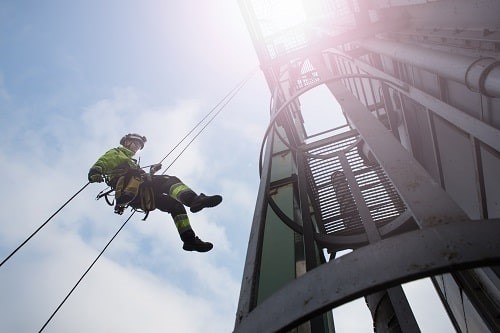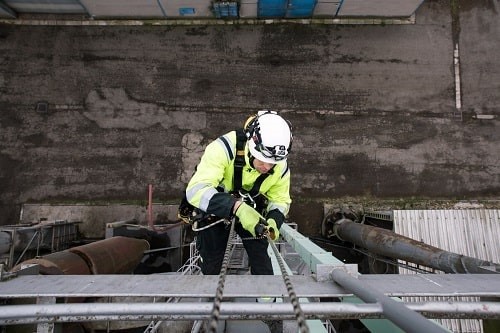Tips on creating a positive health and safety culture to mitigate hazards while working at height.
Features
High risk; higher involvement
Creating, implementing and maintaining a positive health and safety culture within both large and small companies can encompass mitigating a wide range of hazards, as well as the mentality of personnel in the workplace.
The responsibility for creating a positive culture can sit within various roles, normally dependent on the size of the organisation. For larger businesses, it is common best practice to have a dedicated health and safety manager per site, while in smaller businesses, directors and senior management are generally responsible for individual areas such as health and safety, environment, quality and technical. Whether a large or small business, it is important to set guidelines for the safest possible work environment, to ensure people go home safely at the end of each working day.
Some cultural factors such as widespread and repeat procedural violations, the failure to comply with policies, failure in control measures and safety management systems, decisions that repeatedly put cost before safety; focussing on short-term reactive measures and hesitance to act on feedback can influence a poor safety culture.

Falls from a height accounted for 26 per cent of all fatal injuries in GB in 2018 according to HSE.
According to HSE, an effective health and safety culture should include management commitment, visible engagement, consistent and high-quality communication, active employee participation and open-door policy for concerns to be raised.
While a good health and safety culture itself is not enforceable, it can be assessed as part of an incident investigation to address outcomes of a poor culture. Where work at height is concerned, safety measures should be the number one priority for employers.
After 10 years of maintaining an impeccable record of health and safety doing work at height, our directors and senior managers have created a winning formula for creating a positive culture that we are happy to share.
Practical mentality
The person responsible for health and safety should adopt a practical ‘hands-on’ approach when implementing guidelines – involving staff through employee engagement activities such as surveys, while being aware of the risks present on a day-to-day basis, as well as wider considerations such as uncontrollable factors.
Employee involvement
Employee engagement paired with powerful leadership are winning indicators for the basis of a positive culture – minimising risks across your business, as well as increasing wellbeing for your employees, to create active involvement with your health and safety culture initiative.
Leaders
It is important that all directors and senior managers are seen to be both actively involved and following measures once implemented.
Communication
Hold briefing sessions with department heads and team leaders to ensure key messages are communicated throughout your organisation, establishing that employees are encouraged to address safety hazards in line with procedures.

If an employee is injured ensure you are compassionate in the first instance, rather than discussing corrective actions from the offset
Involvement
Whether you are planning to create new guidelines, or update them, ensure that all employees are heard, including those that do not work full time. Running a survey across the entirety of your organisation will give you an overview of safety hazards apparent across all areas, so make sure that the resulting actions are completed in a set timescale to show you are serious about involvement and willing to make changes where applicable.
Feedback
Whether individually, company-wide or publicly, always provide feedback on suggestions and implementations, showing that you are serious about listening to employees’ views.
Compassion
If an employee is injured or has encountered an incident relating to health and safety, ensure you are compassionate in the first instance, rather than discussing corrective actions from the offset.
Reinforce positive behaviour
Reward your employees for involvement when creating, implementing and maintaining a positive health and safety culture.
Committee meetings
Hold a minimum of two annual meetings; go through guidelines to give employees an opportunity to raise concerns around areas that may be failing, areas that are performing well, and provide time for presenting ideas specific to their roles and associated risks.

Share positive results with your vertically orientated team.
Results
Following the implementation and analysis of your guidelines, share the positive results, including statistics and visual aids; this will encourage future involvement and work in line with specified guidelines.
Daily risk assessments
For those in high-risk roles, consider formalising daily risk assessment discussions to raise concerns over factors such as weather changes.
Regulations
The Work at Height Regulations 2005 are set out to prevent death and injury caused by a fall from height. If you are an employer or are in control of work at height (including facilities manager roles and building owners who may contract works externally), these regulations apply to you. Ensure work is properly planned, supervised and carried out by competent personnel and that appropriate equipment is used.
The HSE statistics for 2018 show that falls from height resulting in non-fatal injuries had increased by 1 per cent year on year, further confirming the need to improve health and safety culture around work at height.
HSE Working at height guide here
Ken Diable is managing director at Heightsafe Systems
FEATURES

Sedentary working and how to combat the ‘sitting disease’
By Gavin Bradley, Active Working on 05 April 2024
Prolonged and excessive sitting poses a major risk to our health, but the Get Britain Standing campaign and On Your Feet Britain Day on 25 April are a great way of encouraging workers to sit less and move more.

Company culture and wellbeing: a crucial link
By Bex Moorhouse, Invigorate Spaces on 05 April 2024
Investing in measures to support worker wellbeing will be ineffective unless the company culture genuinely incorporates values like teamwork, involvement, flexibility and innovation.

Office design and culture: happier and healthier staff – or the opposite?
By Guy Osmond, Osmond Ergonomics on 03 April 2024
Applying ergonomic principles to workstation set-ups and ensuring the physical environment supports neurodivergent people are just some of the ways of creating an office where everyone can thrive, but a supportive and positive organisational culture is vital too.


